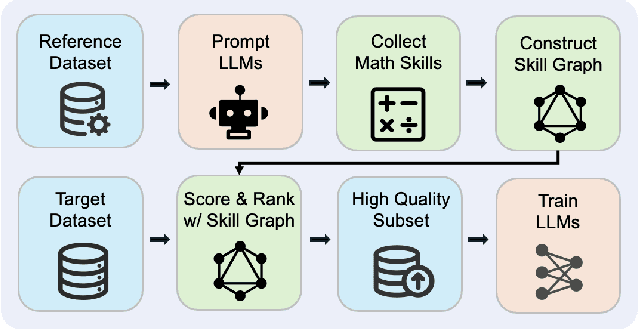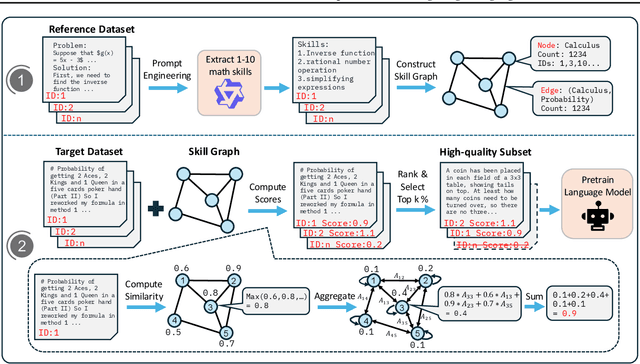Jiazheng Li
Mapping Faithful Reasoning in Language Models
Oct 25, 2025Abstract:Chain-of-thought (CoT) traces promise transparency for reasoning language models, but prior work shows they are not always faithful reflections of internal computation. This raises challenges for oversight: practitioners may misinterpret decorative reasoning as genuine. We introduce Concept Walk, a general framework for tracing how a model's internal stance evolves with respect to a concept direction during reasoning. Unlike surface text, Concept Walk operates in activation space, projecting each reasoning step onto the concept direction learned from contrastive data. This allows us to observe whether reasoning traces shape outcomes or are discarded. As a case study, we apply Concept Walk to the domain of Safety using Qwen 3-4B. We find that in 'easy' cases, perturbed CoTs are quickly ignored, indicating decorative reasoning, whereas in 'hard' cases, perturbations induce sustained shifts in internal activations, consistent with faithful reasoning. The contribution is methodological: Concept Walk provides a lens to re-examine faithfulness through concept-specific internal dynamics, helping identify when reasoning traces can be trusted and when they risk misleading practitioners.
NeuralDB: Scaling Knowledge Editing in LLMs to 100,000 Facts with Neural KV Database
Jul 24, 2025Abstract:Efficiently editing knowledge stored in large language models (LLMs) enables model updates without large-scale training. One possible solution is Locate-and-Edit (L\&E), allowing simultaneous modifications of a massive number of facts. However, such editing may compromise the general abilities of LLMs and even result in forgetting edited facts when scaling up to thousands of edits. In this paper, we model existing linear L\&E methods as querying a Key-Value (KV) database. From this perspective, we then propose NeuralDB, an editing framework that explicitly represents the edited facts as a neural KV database equipped with a non-linear gated retrieval module, % In particular, our gated module only operates when inference involves the edited facts, effectively preserving the general abilities of LLMs. Comprehensive experiments involving the editing of 10,000 facts were conducted on the ZsRE and CounterFacts datasets, using GPT2-XL, GPT-J (6B) and Llama-3 (8B). The results demonstrate that NeuralDB not only excels in editing efficacy, generalization, specificity, fluency, and consistency, but also preserves overall performance across six representative text understanding and generation tasks. Further experiments indicate that NeuralDB maintains its effectiveness even when scaled to 100,000 facts (\textbf{50x} more than in prior work).
QuestA: Expanding Reasoning Capacity in LLMs via Question Augmentation
Jul 17, 2025Abstract:Reinforcement learning (RL) has become a key component in training large language reasoning models (LLMs). However, recent studies questions its effectiveness in improving multi-step reasoning-particularly on hard problems. To address this challenge, we propose a simple yet effective strategy via Question Augmentation: introduce partial solutions during training to reduce problem difficulty and provide more informative learning signals. Our method, QuestA, when applied during RL training on math reasoning tasks, not only improves pass@1 but also pass@k-particularly on problems where standard RL struggles to make progress. This enables continual improvement over strong open-source models such as DeepScaleR and OpenMath Nemotron, further enhancing their reasoning capabilities. We achieve new state-of-the-art results on math benchmarks using 1.5B-parameter models: 67.1% (+5.3%) on AIME24, 59.5% (+10.0%) on AIME25, and 35.5% (+4.0%) on HMMT25. Further, we provide theoretical explanations that QuestA improves sample efficiency, offering a practical and generalizable pathway for expanding reasoning capability through RL.
Graph Prompting for Graph Learning Models: Recent Advances and Future Directions
Jun 10, 2025Abstract:Graph learning models have demonstrated great prowess in learning expressive representations from large-scale graph data in a wide variety of real-world scenarios. As a prevalent strategy for training powerful graph learning models, the "pre-training, adaptation" scheme first pre-trains graph learning models on unlabeled graph data in a self-supervised manner and then adapts them to specific downstream tasks. During the adaptation phase, graph prompting emerges as a promising approach that learns trainable prompts while keeping the pre-trained graph learning models unchanged. In this paper, we present a systematic review of recent advancements in graph prompting. First, we introduce representative graph pre-training methods that serve as the foundation step of graph prompting. Next, we review mainstream techniques in graph prompting and elaborate on how they design learnable prompts for graph prompting. Furthermore, we summarize the real-world applications of graph prompting from different domains. Finally, we discuss several open challenges in existing studies with promising future directions in this field.
Data Mixing Can Induce Phase Transitions in Knowledge Acquisition
May 23, 2025Abstract:Large Language Models (LLMs) are typically trained on data mixtures: most data come from web scrapes, while a small portion is curated from high-quality sources with dense domain-specific knowledge. In this paper, we show that when training LLMs on such data mixtures, knowledge acquisition from knowledge-dense datasets, unlike training exclusively on knowledge-dense data (arXiv:2404.05405), does not always follow a smooth scaling law but can exhibit phase transitions with respect to the mixing ratio and model size. Through controlled experiments on a synthetic biography dataset mixed with web-scraped data, we demonstrate that: (1) as we increase the model size to a critical value, the model suddenly transitions from memorizing very few to most of the biographies; (2) below a critical mixing ratio, the model memorizes almost nothing even with extensive training, but beyond this threshold, it rapidly memorizes more biographies. We attribute these phase transitions to a capacity allocation phenomenon: a model with bounded capacity must act like a knapsack problem solver to minimize the overall test loss, and the optimal allocation across datasets can change discontinuously as the model size or mixing ratio varies. We formalize this intuition in an information-theoretic framework and reveal that these phase transitions are predictable, with the critical mixing ratio following a power-law relationship with the model size. Our findings highlight a concrete case where a good mixing recipe for large models may not be optimal for small models, and vice versa.
Graph Foundation Models: A Comprehensive Survey
May 21, 2025Abstract:Graph-structured data pervades domains such as social networks, biological systems, knowledge graphs, and recommender systems. While foundation models have transformed natural language processing, vision, and multimodal learning through large-scale pretraining and generalization, extending these capabilities to graphs -- characterized by non-Euclidean structures and complex relational semantics -- poses unique challenges and opens new opportunities. To this end, Graph Foundation Models (GFMs) aim to bring scalable, general-purpose intelligence to structured data, enabling broad transfer across graph-centric tasks and domains. This survey provides a comprehensive overview of GFMs, unifying diverse efforts under a modular framework comprising three key components: backbone architectures, pretraining strategies, and adaptation mechanisms. We categorize GFMs by their generalization scope -- universal, task-specific, and domain-specific -- and review representative methods, key innovations, and theoretical insights within each category. Beyond methodology, we examine theoretical foundations including transferability and emergent capabilities, and highlight key challenges such as structural alignment, heterogeneity, scalability, and evaluation. Positioned at the intersection of graph learning and general-purpose AI, GFMs are poised to become foundational infrastructure for open-ended reasoning over structured data. This survey consolidates current progress and outlines future directions to guide research in this rapidly evolving field. Resources are available at https://github.com/Zehong-Wang/Awesome-Foundation-Models-on-Graphs.
Extracting Abstraction Dimensions by Identifying Syntax Pattern from Texts
Apr 26, 2025Abstract:This paper proposed an approach to automatically discovering subject dimension, action dimension, object dimension and adverbial dimension from texts to efficiently operate texts and support query in natural language. The high quality of trees guarantees that all subjects, actions, objects and adverbials and their subclass relations within texts can be represented. The independency of trees ensures that there is no redundant representation between trees. The expressiveness of trees ensures that the majority of sentences can be accessed from each tree and the rest of sentences can be accessed from at least one tree so that the tree-based search mechanism can support querying in natural language. Experiments show that the average precision, recall and F1-score of the abstraction trees constructed by the subclass relations of subject, action, object and adverbial are all greater than 80%. The application of the proposed approach to supporting query in natural language demonstrates that different types of question patterns for querying subject or object have high coverage of texts, and searching multiple trees on subject, action, object and adverbial according to the question pattern can quickly reduce search space to locate target sentences, which can support precise operation on texts.
MASS: Mathematical Data Selection via Skill Graphs for Pretraining Large Language Models
Mar 19, 2025



Abstract:High-quality data plays a critical role in the pretraining and fine-tuning of large language models (LLMs), even determining their performance ceiling to some degree. Consequently, numerous data selection methods have been proposed to identify subsets of data that can effectively and efficiently enhance model performance. However, most of these methods focus on general data selection and tend to overlook the specific nuances of domain-related data. In this paper, we introduce MASS, a \textbf{MA}thematical data \textbf{S}election framework using the \textbf{S}kill graph for pretraining LLMs in the mathematical reasoning domain. By taking into account the unique characteristics of mathematics and reasoning, we construct a skill graph that captures the mathematical skills and their interrelations from a reference dataset. This skill graph guides us in assigning quality scores to the target dataset, enabling us to select the top-ranked subset which is further used to pretrain LLMs. Experimental results demonstrate the efficiency and effectiveness of MASS across different model sizes (1B and 7B) and pretraining datasets (web data and synthetic data). Specifically, in terms of efficiency, models trained on subsets selected by MASS can achieve similar performance to models trained on the original datasets, with a significant reduction in the number of trained tokens - ranging from 50\% to 70\% fewer tokens. In terms of effectiveness, when trained on the same amount of tokens, models trained on the data selected by MASS outperform those trained on the original datasets by 3.3\% to 5.9\%. These results underscore the potential of MASS to improve both the efficiency and effectiveness of pretraining LLMs.
EnigmaToM: Improve LLMs' Theory-of-Mind Reasoning Capabilities with Neural Knowledge Base of Entity States
Mar 05, 2025



Abstract:Theory-of-Mind (ToM), the ability to infer others' perceptions and mental states, is fundamental to human interaction but remains a challenging task for Large Language Models (LLMs). While existing ToM reasoning methods show promise with reasoning via perceptual perspective-taking, they often rely excessively on LLMs, reducing their efficiency and limiting their applicability to high-order ToM reasoning, which requires multi-hop reasoning about characters' beliefs. To address these issues, we present EnigmaToM, a novel neuro-symbolic framework that enhances ToM reasoning by integrating a Neural Knowledge Base of entity states (Enigma) for (1) a psychology-inspired iterative masking mechanism that facilitates accurate perspective-taking and (2) knowledge injection that elicits key entity information. Enigma generates structured representations of entity states, which construct spatial scene graphs -- leveraging spatial information as an inductive bias -- for belief tracking of various ToM orders and enhancing events with fine-grained entity state details. Experimental results on multiple benchmarks, including ToMi, HiToM, and FANToM, show that EnigmaToM significantly improves ToM reasoning across LLMs of varying sizes, particularly excelling in high-order reasoning scenarios.
Two Heads Are Better Than One: Dual-Model Verbal Reflection at Inference-Time
Feb 26, 2025Abstract:Large Language Models (LLMs) often struggle with complex reasoning scenarios. While preference optimization methods enhance reasoning performance through training, they often lack transparency in why one reasoning outcome is preferred over another. Verbal reflection techniques improve explainability but are limited in LLMs' critique and refinement capacity. To address these challenges, we introduce a contrastive reflection synthesis pipeline that enhances the accuracy and depth of LLM-generated reflections. We further propose a dual-model reasoning framework within a verbal reinforcement learning paradigm, decoupling inference-time self-reflection into specialized, trained models for reasoning critique and refinement. Extensive experiments show that our framework outperforms traditional preference optimization methods across all evaluation metrics. Our findings also show that "two heads are better than one", demonstrating that a collaborative Reasoner-Critic model achieves superior reasoning performance and transparency, compared to single-model approaches.
 Add to Chrome
Add to Chrome Add to Firefox
Add to Firefox Add to Edge
Add to Edge